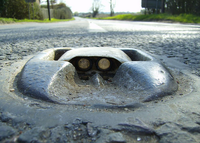








The cat's eye is a retroreflective safety device used in road marking and was the first of a range of raised pavement markers. It originated in the UK in 1933 and is today used all over the world. It consists (in its original form) of two pairs of reflective glass spheres set into a white rubber dome, mounted in a cast-iron housing. This is the kind that marks the centre of the road, with one pair of cat's eyes showing in each direction. A single-ended form has become widely used in other colours at road margins and as lane dividers. Cat's eyes are particularly valuable in fog and are largely resistant to damage from snow ploughs.
A key feature of the cat's eye is the flexible rubber dome which is occasionally deformed by the passage of traffic. A fixed rubber wiper cleans the surface of the reflectors as they sink below the surface of the road (the base tends to hold water after a shower of rain, making this process even more efficient). The rubber dome is protected from impact damage by metal 'kerbs' – which also give tactile and audible feedback for wandering drivers.
The inventor of cat's eyes was Percy Shaw of Boothtown, Halifax, West Yorkshire, England. When the tram-lines were removed in the nearby suburb of Ambler Thorn, he realised that he had been using the polished strips of steel to navigate at night.The name "cat's eye" comes from Shaw's inspiration for the device: the eyeshine reflecting from the eyes of a cat. In 1934, he patented his invention (patent No. 436,290 and 457,536), and on 15 March 1935, founded Reflecting Roadstuds Limited in Halifax to manufacture the items.The name Catseye is their trademark.The reflective lens had been invented six years earlier for use in advertising signs by Richard Hollins Murray, an accountant from Herefordshire and, as Shaw acknowledged, they had contributed to his idea.
The blackouts of World War II (1939–1945) and the shuttered car headlights then in use demonstrated the value of Shaw's invention and helped popularise their mass use in the UK. After the war, they received firm backing from a Ministry of Transport committee led by James Callaghan and Sir Arthur Young. Eventually, their use spread all over the world.
White cat's eyes are used for the centre of a road on many roads which lack street lighting but are subject to high speeds or high volumes of traffic. They are also used for lane markings, soft traffic islands and on "double white lines" where no overtaking is permitted.
Red cat's eyes are placed along the hard shoulder of motorways, dual carriageways, as well as the nearside (left) edge of major A- and B-class roads (often former trunk roads).
Amber cat's eyes are placed along the edge of the central reservation (median).
Green cat's eyes denote joining or leaving slip roads at junctions.
These units are not very visible in daylight and are generally used in conjunction with traditionally painted lines. Temporary cat's eyes with just a reflective strip are often used during motorway repair work. These are typically day glow green/yellow so they are easily visible in daylight as well as in darkness, they can then be used on their own for lane division.
Also seen during motorway repair work are plastic traffic pillars that are inserted into the socket of a retractable cat's eye rather than being free-standing. These are often used in conjunction with two rows of the temporary cat's eyes to divide traffic moving in opposite directions during motorway roadworks.
Solar-powered cat's eyes known as solar road studs and showing a red or amber LED to traffic, have been introduced on roads regarded as particularly dangerous at locations throughout the world.However, shortly after one such installation in Essex in the autumn of 2006 the BBC reported that the devices, which flash almost imperceptibly at 100 times a second, could possibly set off epileptic fits and the Highways Agency had suspended the programme.
Flashing blue LED cat's eyes were demonstrated on the TV show Accident Black Spot, aired on Channel 4 on 19 December 2000, which alert the driver to potential ice on the road when a low enough temperature, provisionally set at 3°C (37°F), is reached. Proposed enhancements, for an "intelligent cat's eye" of the future, will see the standard white light change to amber for four seconds after the passing of a vehicle, or red if the following vehicle is too close or traffic ahead is stationary.